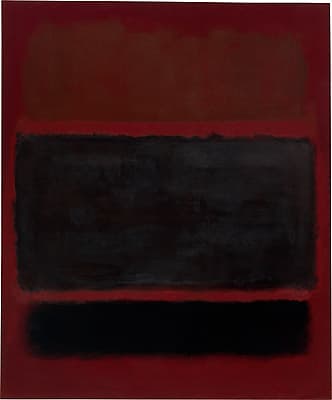
Mark
ROTHKO
Latvia
1903
–
United States of America
1970
1957 # 20
1957
oil on canvas
signed and dated verso u.l., maroon oil paint, "Mark Rothko / 1957"
233.0 (h)
x 193.0 (w)
cm
Unframed
233.0 (h)
x 193.0 (w)
x 4.5 (d)
cm
Purchased 1981
National Gallery of Australia, Canberra
NGA 1981.729
© Mark Rothko/ARS. Licensed by Viscopy
- estate of the artist;
- from whom bought, through The Pace Gallery, New York, by the Australian National Gallery, February 1981
- Mark Rothko
- Museo d'Arte Moderne Ca' Pesaro 25 Jun 1970 – 15 Oct 1970
- Marlborough Gallery Inc 13 Nov 1970 – 05 Dec 1970
- Mark Rothko, 1903-1970: A Retrospective
- Solomon R. Guggenheim Museum 27 Oct 1978 – 14 Jan 1979
- The Museum of Fine Arts, Houston 08 Feb 1979 – 01 Apr 1979
- Walker Art Center 21 Apr 1979 – 10 May 1979
- Los Angeles County Museum of Art 03 Jul 1979 – 26 Sep 1979
- Beyond Belief: Modern Art and the Religious Imagination
- National Gallery of Victoria 23 Apr 1998 – 26 Jul 1998
- Seeking Transcendence
- Art Gallery of Western Australia 10 Feb 2005 – 24 Apr 2005
- Mark Rothko
- Palazzo delle Esposizioni 05 Oct 2007 – 06 Jan 2008
- Mark Rothko - A Retrospective
- Kunsthalle der Hypo-Kulturstiftung 08 Feb 2008 – 27 Apr 2008
- Hamburger Kunsthalle 08 May 2008 – 14 Sep 2008
- Abstract Expressionism: the National Gallery of Australia celebrates the centenaries of Jackson Pollock and Morris Louis
- 14 Jul 2012 – 24 Feb 2013
- James Mollison and Laura Murray (eds), Australian National Gallery: An introduction, Canberra: Australian National Gallery 1982, pp. 60, 62–63, illus. col.;
- Dore Ashton, About Rothko, New York: Oxford University Press 1983, p. 139;
- Michael Lloyd and Michael Desmond, European and American paintings and sculptures 1870–1970 in the Australian National Gallery, Canberra: Australian National Gallery 1992, pp. 248–249, illus., as ‘Brown, black on maroon’;
- An introduction to the National Gallery of Australia, Canberra: National Gallery of Australia 1992, p. 68 , illus. col.;
- Jenny Manning, Sixty minutes in the Gallery, Canberra: National Gallery of Australia, 1993, p. 8, illus. b&w;
- David Anfam, Mark Rothko: The works on canvas: Catalogue raisonné, New Haven, London and Washington: Yale University Press and the National Gallery of Art 1998, cat. 596, p. 461, illus. col.;
- Sasha Grishin, ‘A collection of masterpieces’, in Pauline Green ed., Building the collection, Canberra: National Gallery of Australia 2002, p. 231, illus. col.;
- Anthony White, ‘Art metropolis: A new display of international art’, artonview no. 32, Summer 2002–2003, p. 18, illus. col.;
- Brian Kennedy, ‘The art of Sean Scully: a human spirituality’, Sean Scully: Body of light, Canberra: National Gallery of Australia 2004, p. 10, illus. col.;
- John Stringer, Seeking transcendence, Perth: Art Gallery of Western Australia 2005, p. 18, not illus.;
- Oliver Wick (ed.), Mark Rothko¸ Milano: Skira, 2007,cat. 78 .illus. col. p. 128;
- Collectionhighlights, Canberra: National Gallery of Australia, 2008. p. 230, illus. col.;
- MarkRothko, Retrospektive, München: Hirmer Verlag, 2008, cat. 8 .illus. col. p.[128];
No. 20 (Deep red and black) 1957 is a canvas that is characteristic of Rothko’s mature style, composed of soft‑edged blocks of colour that float above each other. Throughout the early 1950s he employed bright colours—reds, yellow, oranges and blues—in harmonious combinations. But, in 1957, the year this work was painted, a perceptible shift occurred in Rothko's paintings. Fewer and darker colours were used, giving a sombre expression to his work. Rothko was still painting ‘dramas’, a term he had used to describe the subject of his paintings of the 1940s, using colour as the ‘instrument’: ‘I exclude no emotion from being actual and therefore pertinent’, he said in 1957. ‘I take the liberty to play on any string of my existence. I might as an artist, be lyrical, grim, maudlin, humorous, tragic.’[1]
At that time, however, Rothko's paintings reflected a more limited range of mood: among the ‘ingredients’ of his art, which he listed in a lecture he delivered at the Pratt Institute in 1958, was ‘a clear preoccupation with death. All art deals with intimations of mortality’.[2] To Dore Ashton, a regular visitor to his studio at this time, Rothko claimed that ‘he was creating the most violent painting in America’.[3] Ashton interpreted this as referring to the conflict inherent in the association of colours that Rothko conceived of as the symbolic equivalents of emotions. As Rothko believed, ‘a painting is not a picture of an experience; it is an experience’.[4] The ‘dark’ emotions that permeate No. 20 (Deep red and black), and other paintings of 1957, were, with certain exceptions, the basis for all the works that Rothko painted until he killed himself, a little over a decade later.
Michael Lloyd and Michael Desmond, European and American paintings and sculptures 1870–1970 in the Australian National Gallery, Canberra: Australian National Gallery 1992, p. 250, revised Steven Tonkin 2003
[1]Elaine de Kooning, 'Kline and Rothko: Two Americans in action', Artnews Annual XXVII, 1958, p. 177
[2]Taken from Rothko’s notes for a lecture given in 1958 at the Pratt Institute, Brooklyn, and published by Dore Ashton in The New York Times,31 October 1958, reprinted in The New York School, Los Angeles: Los Angeles County Museum of Art 1965, p. 142.
[3] Dore Ashton, About Rothko, New York: Oxford University Press 1983, p. 138.
[4] Rothko, quoted in Anne C. Chave, Mark Rothko: Subjects in Abstraction, New Haven and London: Yale University Press 1989, p. 172
The National Gallery of Australia holds two paintings by Rothko, Untitled (Multiform)1948 and No. 20 (Deep red and black) 1957, and a drawing Untitled c 1944–46.
